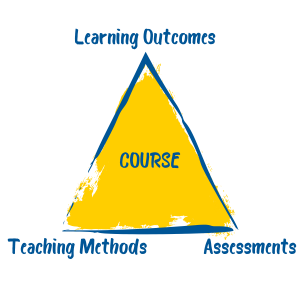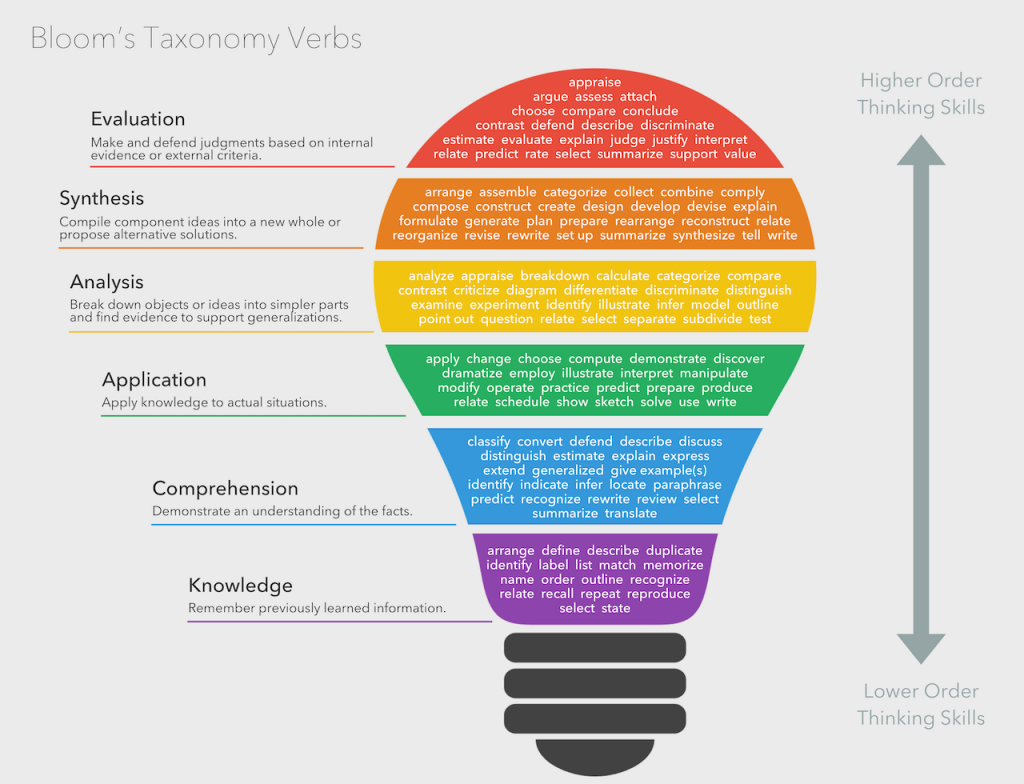Pre-workshop Activities
Learning Outcomes
Watch this brief video on Learning Outcomes:
Format of Learning Outcomes
| Stem | Introduce the timeline for this learning outcome (lesson, module, course, program) | On completion of this module, a successful student will be able to: |
| Active verb | Identify the ability to be MEASURED | create |
| Concept/Skill/Attitude | specify the knowledge, skill, or value and how it will be demonstrated | learning outcomes for their mini-lesson. |
Aligning Your Outcomes, Methods, and Assessments

The Three Essentials of Alignment
- Teaching methods should help students develop the knowledge and skills specified in the learning outcomes.
- Teaching Methods are the MEANS. Learning outcomes are the ENDS. How will you get your students to where they need to be?
- Assessments should determine whether, and to what degree, students have achieved the learning outcomes.
- Assessments are the MEANS of determining if the students have achieved the END.
- Teaching methods, assessments, and learning outcomes should be consistent and coherent.
Useful Verbs for Use in Learning Outcomes
(Adapted from Park University Faculty Development: Quick Tips)
You don’t have to agree with Bloom’s classification scheme. These are just useful verbs for learning outcomes!
| Domain | Emphasis | Relevant Verbs |
| Cognitive | Knowledge | Recall, identify, recognize, acquire, distinguish, state, define, name, list, label, reproduce, order, indicate, record, relate, repeat, select |
| Cognitive | Comprehension | Translate, extrapolate, convert, interpret, abstract, transform, select, indicate, illustrate, represent, formulate, explain, classify, describe, discuss, express, identify, locate, paraphrase, recognize, report, restate, review, summarise, translate |
| Cognitive | Application | Apply, sequence, carry out, solve, prepare, operate, generalize, plan, repair, explain, predict, demonstrate, instruct, compute, use, perform, implement, employ, solve, construct, demonstrate, give examples, illustrate, interpret, investigate, practice |
| Cognitive | Analysis | Analyze, estimate, compare, observe, detect, classify, discover, discriminate, explore, distinguish, catalogue, investigate, breakdown, order, determine, differentiate, dissect, contrast, examine, interpret, calculate, categorise, debate, diagram, experiment, question, solve |
| Cognitive | Synthesis | Write, plan, integrate, formulate, propose, specify, produce, organize, theorize, design, build, systematize, combine, summarize, restate, argue, discuss, derive, relate, generalize, conclude, produce, arrange, assemble, collect, compose, construct, create, organise, perform, plan, prepare, propose |
| Cognitive | Evaluation | Evaluate, verify, assess, test, judge, rank, measure, appraise, select, check, justify, determine, support, defend, criticize, weigh, assess, choose, compare, contrast, decide, estimate, grade, rate, revise, score |
| Affective | Agree, avoid, support, participate, cooperate, praise, help, offer, join | |
| Psychomotor | Adjust, repair, taste, bend, measure, perform, operate, use, move |

The Sinister Sixteen (Problem words/phrases)
These are passive, internal, or otherwise unobservable. You can never really know if Susan understands the concept of osmosis, you can only rely on observable behaviours that you are willing to accept as evidence that Susan probably understands.
| Understand | Be aware of |
| Appreciate | Be conscious of |
| Comprehend | Perceive |
| Know | Value |
| Grasp | Learn |
| See | Apprehend |
| Accept | Be familiar with |
| Have a knowledge of | Get |
Ask yourself:
- Is this outcome public and observable?
- How will I, and the students, know when this outcome has been achieved?
- Does the learning outcome follow from the stem (is it a complete sentence)?
- Is it about the ends not the means? (what students will be able to do when they leave the course, not the specific assignments they complete in the course)
Real Examples
1) Is it public and observable?
Bad Example:
Upon successful completion of this course, you should be able to:
-
- Appreciate the intricacy of theoretical constructs
- Understand theory
- Think about complex adaptations
2) How will I, and the students, know when the outcome has been achieved? (Is it clear enough for students?)
Bad Example:
Upon successful completion of this course, you should be able to:
-
- simulate a sizeable process
- work effectively in a project team
3) Does it follow the stem – Does it make a complete sentence when you read it out loud?
Bad Example:
At the end of this course, students will be able to:
-
- Have done team skills
- Have an introductory knowledge of bridge building
- Good safe practice
4) Is it about the ends, not the means?
(what students will be able to do when they leave the course, not the specific assignments they complete in the course)
Bad Example:
Upon successful completion of this course, you should be able to:
-
- The course includes a group project requiring teamwork and collaboration skills
- Get involved in team works and independent studies through assignments and projects
- Formulate answers to assignment problems
Why Care About Learning Outcomes?
Strategic use of learning outcomes in your teaching and course design can result in many potential benefits. A few of these are summarized below. References for further reading about the benefits and strategic use of learning outcomes are provided at the end.
Better Learning
Learning outcomes can be used to provide guidance for students, so they know what is expected of them, and thus, what they should focus on in their studying, attend to in class, and look for in their readings. This focused time-on-task means less time is wasted. They can also be used to set high expectations – that we then support with strategic teaching – so we push our students to learn more than they believe they are able. Students find outcome-based courses more rewarding, more effective, and less frustrating – even when they also report that the courses are more demanding!
Increased Motivation
Learning outcomes reinforce the belief that there is a real point to what is being taught and assessed, that there is a reason for what they experience in their courses. Students are less likely to become cynical and dismissive of courses that seem to have a point, and more motivated to take them seriously. Overall, students take a deeper approach to their learning, putting their efforts into actively trying to understand what they are learning, rather than simply memorizing lists of facts to get through an exam.
Better Performance on Assignments and Tests
Not surprisingly, when students know exactly what they are expected to demonstrate, they are better able to demonstrate those things. They spend less time trying to guess what the instructor wants, or what’s in the instructor’s head, and more time getting the job done.
Focused Teaching
Anyone who has made the switch to outcome-based teaching will tell you that it can transform the way you plan courses and classes – for the better. By defining what students are supposed to know, value, and be able to do at the end of a course, you generate questions to guide your teaching – most importantly, “How will this class help students achieve the learning outcomes for this course?” It’s a simple question with a big impact.
Strategic Teaching
Once you have created learning outcomes for your course, you can use them to plan lessons that strategically target those outcomes, so that your classes have a greater likelihood of helping students learn what they need to learn. Each learning outcome excludes irrelevant teaching approaches and suggests a variety of approaches that will help your students succeed. Focused and strategic teaching “narrows the gap” between teaching and learning, so that when we teach, students learn.
Many people who have adopted a strategic, outcomes-based approach find that what they assumed were intractable problems with their students and their teaching vanish when courses, lessons, and assessments are outcome-oriented and mutually consistent.
Strategic Assessment
Just as learning outcomes can be used to create strategically-targeted lessons, they can be used to create strategically-targeted and appropriate assessment methods. Assessments that test whether students have met the learning outcomes are also likely to be consistent with the sorts of teaching methods that help students learn those outcomes. Assessment becomes part of the students’ overall learning experience. The learning outcomes even provide a basis for assessment criteria.
Attention to Outputs
The use of learning outcomes helps us focus on the outputs of our work, rather than the inputs. We work with the students we have, and what matters, in the end, is how much they have learned and transformed between the time they meet us and the time they leave us – that’s where we can make a difference. A student who enters our university by the skin of his teeth, barely meeting the entrance requirements, but graduates as someone able to meet our highest expectations – as set by our learning outcomes – is the sort of success story we should be writing.
Meeting Requirements
Even if none of the benefits mentioned above appeals to you, perhaps the following will suffice: program-level learning outcomes are now required for university programs in Ontario, they are increasingly being required by professional accreditation boards, and outcome-based education is now the de facto approach to post-secondary education in the English-speaking world – because the benefits of an outcome-based approach are so widely recognized. In an increasingly competitive globalized world, Canada can no longer afford to fall behind.
References
- This material was adapted from the UWindsor CTL’s Primer on Learning Outcomes.
- John Biggs (1996), “Enhancing Teaching through Constructive Alignment”, Higher Education, vol 32, no 3, pp. 347-364.
- John Biggs and Catherine Tang (2009). Teaching for Quality Learning at University: What the Student Does. 3rd edition. Berkshire, England: Society for Research into Higher Education & Open University Press.
- John Burke (ed) (1995). Outcomes, Learning and the Curriculum. London: The Falmer Press.
- Amy Driscoll & Swarup Wood (2007). Developing Outcomes-based Assessment for Learner-centred Education: A Faculty Introduction. Sterling, Virginia: Stylus.
- Richard Hall, (2002), “Aligning learning, teaching and assessment using the web: an evaluation of pedagogic approaches”, British Journal of Educational Technology, vol 33, no 2, pp. 149-158.
- Richard Ladyshewsky (2006), “Aligning assessment, rewards, behaviours and outcomes in group learning tasks”, Enhancing Student Learning: 2006 Evaluations and Assessment Conference.
- Chris Rust (2002), “The Impact of Assessment on Student Learning: How Can the Research Literature Practically Help to Inform the Development of Departmental Assessment Strategies and Learner-Centred Assessment Practices?”, Active Learning in Higher Education, vol 3, no 2, pp. 145-158.
- Alenoush Saroyan & Cheryl Amundsen (eds) (2004). Rethinking Teaching in Higher Education. Sterling, Virginia: Stylus.
- John Shepherd (2005), “Weaving a web of consistency: a case study of implementing constructive alignment”, HERDSA 2005 Conference Proceedings.
Media Attributions
- Alignment © Ashlyne O'Neil is licensed under a CC BY (Attribution) license
- Bloom’s_Taxonomy_Verbs_wikicommons © Fractus Learning is licensed under a CC BY-SA (Attribution ShareAlike) license

